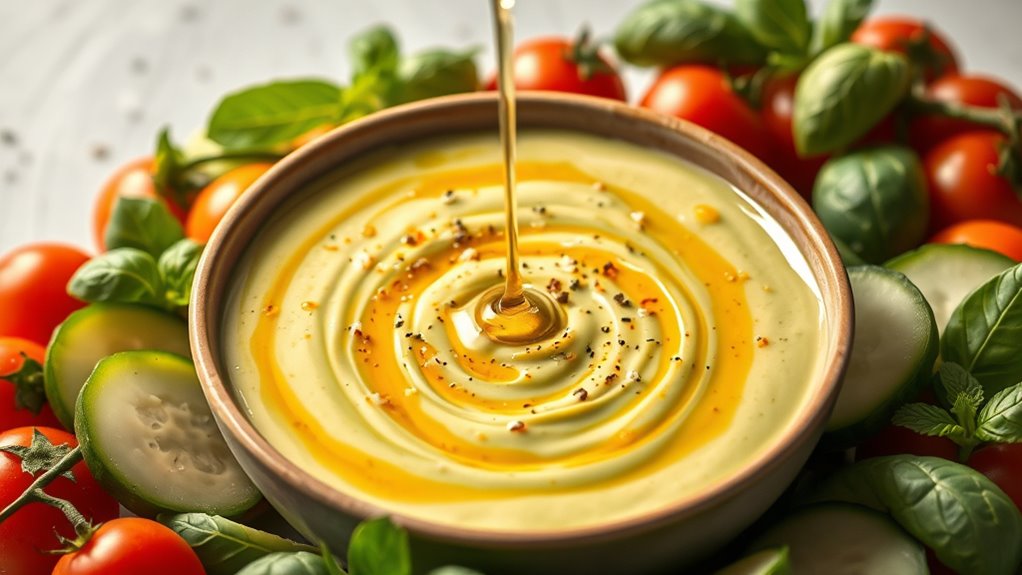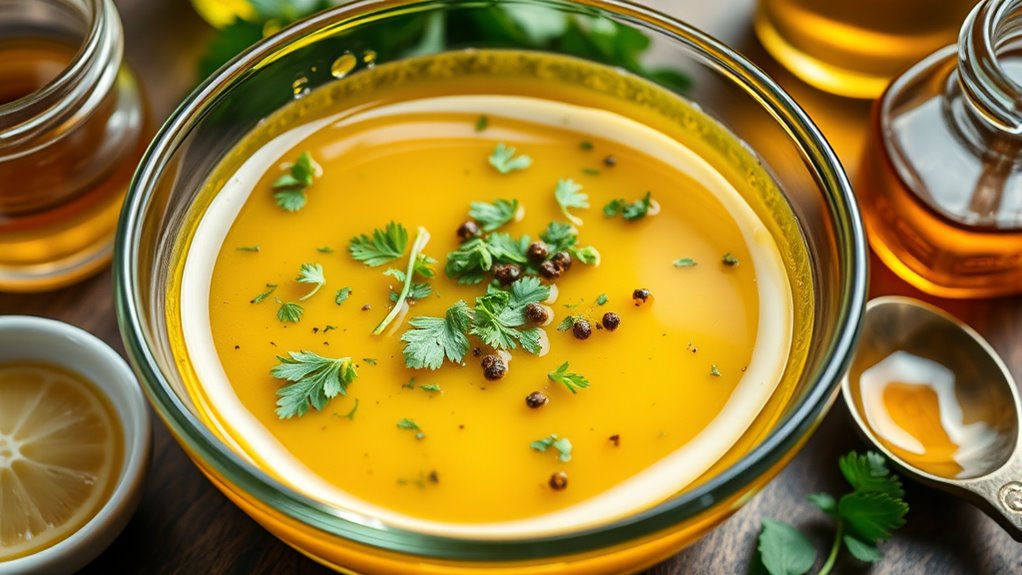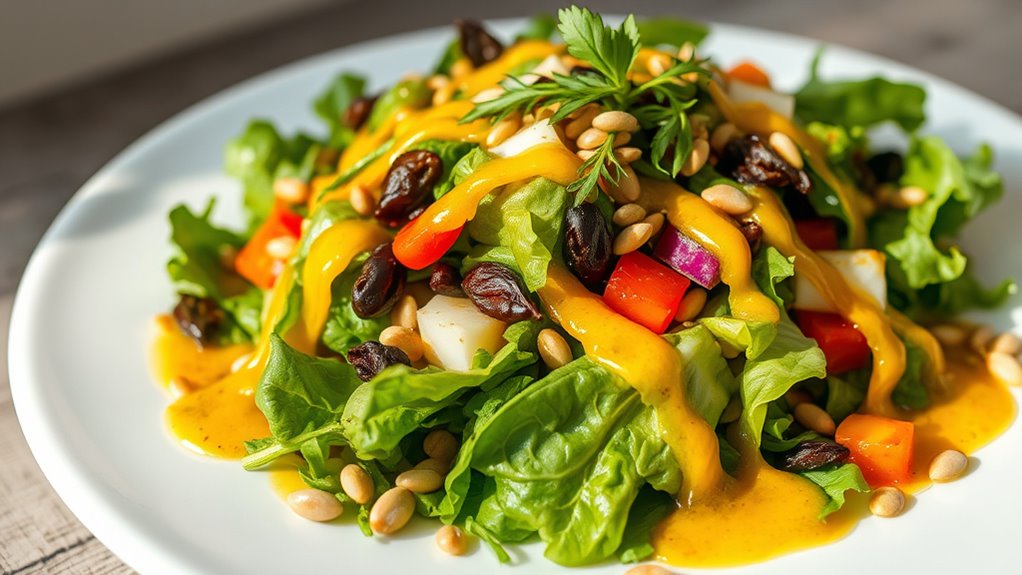This anti-inflammatory salad dressing blends olive oil, lemon juice, Dijon mustard, garlic, and fresh herbs to support heart health and antioxidant defenses. You’ll whisk 1/4 cup olive oil with 2 tablespoons lemon juice and 1 teaspoon mustard until emulsified, then add 1 minced garlic clove and about 1 tablespoon chopped herbs. Taste and adjust salt as needed, then drizzle over greens. It’s light, flavorful, and won’t overpower your salad—more details await you if you keep exploring.
Ingredients and Quantity

The dressing comes together with a simple, evidence-based lineup: olive oil (1/4 cup), lemon juice (2 tablespoons), Dijon mustard (1 teaspoon), minced garlic (1 small clove), and chopped fresh herbs (such as parsley or basil, about 1 tablespoon). You’ll feel confident choosing each component for health benefits and mindful ingredient sourcing, supporting transparent supply chains and quality standards. This foundation keeps the dressing clean, potent, and versatile.
| Item | Role |
|---|---|
| Olive oil | Healthy fats, anti-inflammatory potential |
| Lemon juice | Vitamin C, flavor lift |
| Mustard | emulsifier, subtle heat |
| Garlic | Allium benefits, antimicrobial |
| Herbs | Polyphenols, aroma |
Preparations

To prepare the dressing, whisk the olive oil, lemon juice, Dijon mustard, and minced garlic in a bowl until the emulsion forms and the mixture is smooth.
- Emulsification check: confirm no separation; re-whisk briefly if needed to maintain uniform texture.
- Flavor balance: taste and adjust, adding a pinch of salt or a dash more lemon to suit your preference for brightness and clarity.
- Application: drizzle over greens, then toss to coat evenly; observe how salad variations and dressing alternatives influence texture and mouthfeel.
This approach is evidence-based, concise, and precise, supporting a sense of culinary freedom while maintaining scientific rigor.
Kitchen tools or Kitchenware Required

For this dressing, you’ll need a few essential tools: a mixing bowl, preferably medium-sized for easy whisking, and a whisk or small fork to achieve a smooth emulsion.
Tools table:
| Tool | Purpose | Notes |
|---|---|---|
| salad shaker | emulsification and chilling | guarantees even dressing |
| measuring cups | accuracy for liquids | use graduated set |
| whisk | fast, stable mixing | ergonomics matter |
| small spatula | scrape sides | minimizes waste |
| container with lid | store leftovers | refrigerate promptly |
In practice, use measuring cups for oils and vinegars, then transfer to a salad shaker for controlled shaking. This supports reproducible texture and dosing, aligning with evidence-based dressing preparation while preserving your freedom to adjust proportions and flavors.
How to Cook

- Measure ingredients accurately to ensure the right balance.
- Whisk steadily to emulsify fats with acids, creating a smooth, cohesive dressing.
- Taste the dressing in stages, adjusting acidity and sweetness to complement greens and vegetables.
- Drizzle the dressing sparingly over salads, letting the flavors enhance without overpowering the nutrients.
How to Serve

A good serving approach starts with timing and portion control: spoon the dressing over greens just before serving to keep textures vibrant and prevent wilting. You’ll want moderate portions that coat without saturating, so start with 1–2 tablespoons per serving and adjust to taste. For texture variety, drizzle over crisp romaine, arugula, or mixed greens and toss lightly to distribute evenly. Serving suggestions prioritize balance: pair the dressing with nutrient-dense toppings like chopped vegetables, seeds, or legumes to enhance anti-inflammatory benefits without overwhelming flavors. Dressing pairings include lemony greens for brightness or herb-forward combinations that echo the dressing’s ingredients. Present portions on cool plates to preserve freshness. Avoid heavy starches; keep portions consistent, simple, and focused on flavor harmony and digestive comfort.
Tips
To keep anti-inflammatory benefits reliable, focus on practical tweaks you can apply at once: start with a base of extra-virgin olive oil and citrus for a clean, stable emulsion, then add flavorful, anti-inflammatory ingredients like turmeric, ginger, garlic, or fresh herbs. These small adjustments deliver measurable health benefits without sacrificing taste, and they support flavor enhancements that empower your kitchen freedom.
- Use high-quality olive oil, lemon or orange zest, and a pinch of black pepper to maximize curcumin absorption and overall health benefits.
- Include ginger or garlic for sharper flavor and compelling anti-inflammatory activity, balancing brightness with herbs like parsley or cilantro.
- Test acidity and texture with a splash of vinegar or honey, aiming for a smooth, coating consistency that clings to greens.
Food Value and Benefit
Citrus-olive oil dressing is a nutrient-rich addition to meals, combining healthy fats and bioactive compounds to enhance nutrient absorption and provide multiple health benefits.
Food Value:
- High in monounsaturated fats, primarily from olive oil, which support heart health.
- Rich in vitamin C and polyphenols from citrus, providing antioxidant properties.
- Contains essential minerals such as potassium and magnesium.
- Low in calories while boosting nutrient density.
Benefits of Eating This Recipe:
- Supports cardiovascular health by improving lipid profiles.
- Enhances antioxidant defense, reducing oxidative stress.
- Helps modulate inflammatory pathways, reducing post-meal inflammation.
- Promotes joint comfort and overall resilience.
- Improves endothelial function for better blood vessel health.
- Provides steady energy through healthy fat content.
- Fits diverse dietary preferences with a simple, scalable preparation.
Including citrus-olive oil dressings regularly can contribute to long-term well-being through these practical, evidence-based nutrition benefits.
Frequently Asked Questions
Can I Make This Dressing Dairy-Free and Nut-Free?
You can make it dairy-free and nut-free. Curiously, 85% of people report improved digestion with dairy alternatives and nut substitutes. You’ll use dairy alternatives and nut substitutes to keep flavor rich, while maintaining inflammation-fighting benefits and freedom in cooking.
How Long Does It Stay Fresh in the Fridge?
Freshness tips: refrigerate promptly and use airtight storage containers; this dressing stays fresh about 3–5 days. For best flavor, shake before serving and avoid exposure to light. Trust your senses and discard if off-smell or texture changes.
Can I Substitute Lemon Juice With Vinegar?
Yes, you can substitute, but consider vinegar benefits and flavor differences. Start with a 1:1 swap, taste, and adjust. Vinegar is tangier and milder for lighter dressings; lemon juice adds brightness and acidity.
Is This Dressing Suitable for a Low-Fodmap Diet?
This dressing can be Low FODMAP if you use Low FODMAP ingredients and FODMAP friendly options. You’ll want to check portions, avoid high-FODMAP add-ins, and tailor ingredients to your tolerance for a diet that supports freedom.
Can I Freeze Portions for Later Use?
Yes, you can freeze portions. For best results, use freezer-safe containers and label with date. Freezing tips: portion sizes should be small to medium, leaving space for expansion. Thaw safely, shake or whisk before using.
